Facet Joint Sprain
Updated:
(Also known as Facet Joint Pain, Back Sprain, Zygapophyseal Joint Sprain, Sprained Facet Joint, Facet Joint Dysfunction, Apophyseal Joint Sprain)
What is a facet joint sprain?
The spine comprises of many bones known as vertebrae. Each vertebra connects with the vertebra above and below via two types of joints: the facet joints on either side of the spine and the discs centrally (figure 1). These joints are designed to support body weight and enable spinal movement.
Each facet joint comprises of smooth cartilage which lies between the bony joint surfaces cushioning the impact of one bone on another. Strong connective tissue also wraps around the bony ends providing support to the joint.During certain movements of the spine, stretching or compressive forces are placed on the facet joint. If these forces are excessive and beyond what the facet joint can withstand, injury to the facet joint may occur. This may involve damage to the cartilage or tearing to the connective tissue surrounding the joint. This condition is known as a facet joint sprain.
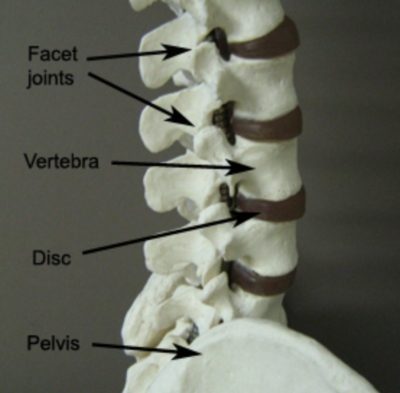
Causes of a facet joint sprain
Facet joint sprains typically occur during excessive bending (i.e. forwards, backwards or sideways), lifting or twisting movements. They may occur traumatically or due to repetitive or prolonged forces.
Signs and symptoms of a facet joint sprain
Patients with a facet joint sprain may experience a sudden onset of back pain during the causative activity. However, it is also common for patients to experience pain and stiffness after the provocative activity, particularly the next morning. Symptoms are typically felt on one side of the spine and muscle spasm may be experienced around the affected joint. Occasionally pain may be referred into the buttock or lower limb on the affected side. Symptoms are generally exacerbated with activities that involve twisting, lifting, arching backwards, bending forwards or sideways or sitting for prolonged periods of time.
Diagnosis of a facet joint sprain
A thorough subjective and objective examination from a physiotherapist is usually sufficient to diagnose a facet joint sprain. Investigations such as an MRI or CT scan may be required to confirm diagnosis.
Treatment for a facet joint sprain

Members Only ContentBecome a PhysioAdvisor Member to gain full access to this exclusive content. For more details see Become a Member. Already a member? Login Now
Prognosis of a facet joint sprain
The recovery time for a facet joint sprain may vary from patient to patient depending on compliance with physiotherapy. With ideal treatment, patients may be pain free in as little as several days, although typically this may take 2 – 3 weeks. It is important to note, however, that injured tissue takes approximately six weeks to restore the majority of its strength in ideal healing conditions. Care must therefore be taken when returning to activity during this period.
Physiotherapy for a facet joint sprain
Physiotherapy for a facet joint sprain can hasten the healing process, ensure an optimal outcome and minimise the likelihood of future recurrence. Treatment may comprise:
- soft tissue massage
- electrotherapy (e.g. ultrasound)
- mobilization
- manipulation
- dry needling
- postural taping
- the use of a back brace
- the use of a lumbar roll for sitting
- education
- activity modification advice
- biomechanical correction
- ergonomic advice
- clinical Pilates
- hydrotherapy
- exercises to improve flexibility, strength, posture and core stability
- a gradual return to activity program
Contributing factors to the development of a facet joint sprain
There are several factors that may contribute to the development of a facet joint sprain. These factors need to be assessed and corrected with direction from a physiotherapist and may include:
- poor posture
- lumbar spine stiffness
- a sedentary lifestyle
- poor core stability
- muscle weakness or tightness
- muscle imbalances
- inappropriate lifting technique
- being overweight
- biomechanical abnormalities
- a lifestyle involving large amounts of sitting, bending or lifting
Other intervention for a facet joint sprain
Despite appropriate physiotherapy management, a small percentage of facet joint sprains fail to improve and may require other intervention. This may include pharmaceutical intervention, investigations such as an X-ray, CT scan or MRI, or assessment from a specialist. A corticosteroid injection into the facet joint may sometimes be used to help alleviate symptoms. The treating physiotherapist or doctor can advise on appropriate management and can refer to the appropriate medical authority if it is warranted clinically.
Exercises for a facet joint sprain
The following exercises are commonly prescribed to patients with this condition. You should discuss the suitability of these exercises with your physiotherapist prior to beginning them. Generally, they should be performed 3 times daily and only provided they do not cause or increase symptoms.
Your physiotherapist can advise when it is appropriate to begin the initial exercises and eventually progress to the intermediate, advanced and other exercises. As a general rule, addition of exercises or progression to more advanced exercises should take place provided there is no increase in symptoms.
Initial Exercises
Transversus Abdominus Retraining
Slowly pull your belly button in “away from your belt line” and breathe normally. Your rib cage should remain relaxed and should not elevate during this process. You should be able to feel the muscle contracting if you press deeply 2cm in from the bony process at the front of your pelvis (figure 3). Practise holding this muscle at one third of a maximal contraction for as long as possible during everyday activity (e.g. when walking etc.) provided it is pain free. Repeat 3 times daily.
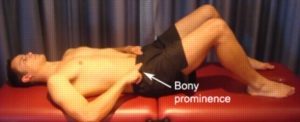
Rotation in Lying
Begin this exercise lying on your back as demonstrated (figure 4). Slowly take your knees from side to side as far as you can go without pain and provided you feel no more than a mild to moderate stretch. Repeat 10 times provided there is no increase in symptoms.
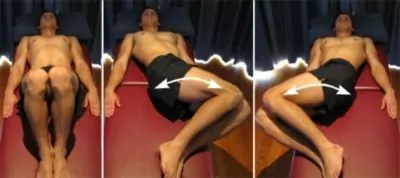
Elbow Prop
Begin lying on your front (figure 5). Slowly move up onto your elbows provided there is no increase in symptoms. Hold this position for 2 seconds and then return to lying flat. Repeat 10 times provided the exercise is pain free.
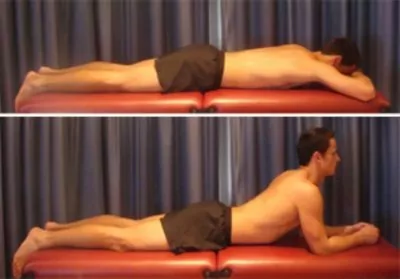

Members Only ContentBecome a PhysioAdvisor Member to gain full access to this exclusive content. For more details see Become a Member. Already a member? Login Now
Intermediate Exercises

Members Only ContentBecome a PhysioAdvisor Member to gain full access to this exclusive content. For more details see Become a Member. Already a member? Login Now
Advanced Exercises

Members Only ContentBecome a PhysioAdvisor Member to gain full access to this exclusive content. For more details see Become a Member. Already a member? Login Now
Other Exercises

Members Only ContentBecome a PhysioAdvisor Member to gain full access to this exclusive content. For more details see Become a Member. Already a member? Login Now
Rehabilitation Protocol for a facet joint sprain

Members Only ContentBecome a PhysioAdvisor Member to gain full access to this exclusive content. For more details see Become a Member. Already a member? Login Now
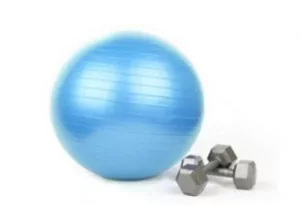
Physiotherapy products for a facet joint sprain
Some of the most commonly recommended products by physiotherapists to hasten healing and speed recovery in patients with this condition include:
-
 Wheat Bags
Wheat Bags -
 Oppo Industrial Back Support (OPP2169)
Oppo Industrial Back Support (OPP2169) -
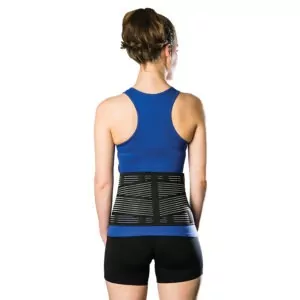 AllCare Ortho Light Back Support
AllCare Ortho Light Back Support -
 Premium Strapping Tape 38mm (Victor)
Premium Strapping Tape 38mm (Victor) -
 AllCare Pro-TENS Machine
AllCare Pro-TENS Machine -
 AllCare Spikey Massage Ball
AllCare Spikey Massage Ball -
 Fixomull Stretch 5cm x 10m
Fixomull Stretch 5cm x 10m -
 AllCare Instant Cold Pack (15 x 25cm)
AllCare Instant Cold Pack (15 x 25cm) -
 BakBalls
BakBalls -
 McKenzie Treat Your Own Back Book
McKenzie Treat Your Own Back Book -
 Lumbar Rolls (‘D’ Shaped)
Lumbar Rolls (‘D’ Shaped)
To purchase a physiotherapy product for a facet joint sprain, click on one of the above links or visit the PhysioAdvisor Shop.

Other Exercises
- View more Lower Back Stretches.
- View more Lower Back Strengthening Exercises.
- View Basic Pilates Exercises to improve your posture and core stability.
- View Core Stability Exercises.
- View Cardiovascular Exercise.
 Recommended Reading
Recommended Reading
- When to use Ice or Heat
- Initial Injury Management & the R.I.C.E. Regime.
- Safe Lifting
- Ergonomic Computer Setup
- Choosing a School Bag
- Back Taping Techniques
- Correct Posture
- Return to Running following Injury
- Return to Sport following Injury
- Lower Back Pain Diagnosis Guide
 Find a Physio for a facet joint sprain
Find a Physio for a facet joint sprain
Find a physiotherapist in your local area who can treat a facet joint sprain.
Become a PhysioAdvisor Member

Link to this Page
If you would like to link to this article on your website, simply copy the code below and add it to your page:
<a href="https://physioadvisor.com.au/injuries/lower-back/facet-joint-sprain”>Facet Joint Sprain – PhysioAdvisor.com</a><br/>PhysioAdvisor offers expert physiotherapy advice and information on back sprains and facet joint sprains including causes, symptoms, diagnosis, treatment, exercises and physiotherapy products.
Return to the top of Facet Joint Sprain.

